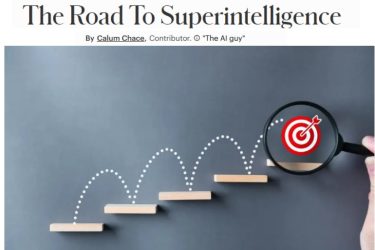An Apple a day…
Later this year, the 7th series of the phenomenally successful Apple Watch will be launched. The company has unveiled a new watch every September since 2015, and the cottage industry of Apple followers speculates that the series 7 will feature blood glucose measurement, using a relatively new technology of terahertz electromagnetic radiation. Blood glucose measurement is especially useful for diabetics. Blood alcohol measurement, and better sleep monitoring are also candidates for inclusion this time round.
With the Watch, Apple has not simply added another device to its product line-up. CEO Tim Cook has lofty ambitions for the company in the healthcare sector: “I really believe that if you zoom out to the future and then look back and ask, ‘What has Apple’s greatest contribution been?’ it will be in the health and wellness area.” At the heart of this contribution will be artificial intelligence.
Apple’s vision for the future of healthcare is shared by the American cardiologist and author Eric Topol, who has written a series of successful books describing how wearable sensors will monitor us continuously, and feed the data to automated systems that will keep a constant watch for danger signals, and detect when something is amiss in good time to have it fixed before it becomes a serious problem. AI systems – with rigorous privacy precautions – will also trawl through the resulting oceans of data, looking for patterns, and yielding unexpected discoveries about how pathologies develop, and how to detect them early on.
The future of healthcare is on your wrist
Apple does not disclose sales figures by product, but analysts estimate that since it was launched in 2015, 100 million Watches have been sold. In the US, one-third of iPhone users also buys an Apple Watch, and the company now sells more watches than the entire Swiss watch industry combined.
With the launch of the series 6, blood oxygen monitoring was added to the ECG (electrocardiogram) and heart rate measurement offered in older models. The ECG gained FDA approval for the first time, and the device also offered sleep-tracking capability. The product’s slogan is “The future of healthcare is on your wrist”.
Apple is not the only tech giant showing a keen interest in healthcare. Google’s parent Alphabet has several initiatives, including a data-focused anti-ageing research group called Calico, and a spin-off called Verily, which develops devices and software. And of course, Apple and Google teamed up last year to offer an app to governments around the world to track Covid infections. But no-one does devices quite like Apple does devices.
AI and the Big Bang
Apple was a relative latecomer to the AI party, and its relatively un-collegiate approach to working across company boundaries was an impediment, along with its stand against the collection of customer data. But it has found ways around these limitations, allowing its researchers to publish their findings, and utilising data on customer devices, without uploading it to company servers.
Artificial intelligence is a 65 year-old science, but despite impressive achievements like beating the best human chess player back in 1997, it only began to show its real promise after the Big Bang in 2012. This is when machine learning was successfully co-opted to the discipline, and in particular, the subset of machine learning known as deep learning, which is essentially a re-branding of neural nets. Since then we’ve seen the stunning victory of Alpha Go against the best human players of the board game Go, and the remarkably powerful natural language processing system GPT-3. We’ve also seen my personal favourite: a system developed in Singapore that built an IKEA chair in nine minutes – without swearing once.
Since the 2012 Big Bang, Google and Facebook have used AI to appropriate much of the advertising industry, much to the chagrin of Rupert Murdoch and his fellow media moguls. But elsewhere, real-world progress with AI deployment has been unspectacular, and often hard to discern at all. This shouldn’t surprise us. AI is a general technology, and a hard one to master. It took a couple of generations for electricity to replace steam power in factories. The AI revolution won’t all happen overnight, either.
Prevention is better than cure
Health is an obvious domain to target with AI. In most countries, there is a shortage of doctors because it costs a lot of time and treasure to train them. There is never enough money to buy all the healthcare a population needs, so one way or another, it is rationed. In general, the medical profession ignores us until we are sick, so our healthcare systems are actually sick care rather than health care.
AI could help reverse this. As patients, we generate a great deal of data, and although health budgets are never large enough, they are nevertheless enormous in absolute terms. An abundance of data and money creates an environment in which AI could be very effective. The combination of wearable devices and powerful AI should enable healthcare to become predictive maintenance rather than repair – prevention rather than cure.
Over-optimism
AI systems have already demonstrated impressive capabilities in various medical domains. Numerous studies have shown that AIs can read photographs and X-rays and diagnose problems more reliably than trained humans can. And of course they don’t get tired, or need lunch breaks.
This has prompted some over-optimistic prognoses about their capabilities. In 2016, one of the world’s leading AI researchers, Geoff Hinton, declared that radiotherapists were like the Wily Coyote from the Roadrunner cartoon: they had already run off the edge of the cliff, but they had not yet looked down to see their fate lying below them. It is an open question about whether and when radiologists will eventually be replaced by AIs, but at the very least, Hinton’s timing was out. A recent study by the American College of Radiology found that a third of all US radiology departments now use AI in some form, about half of them for breast screening. So far, the technology is a tool for radiologists rather than a replacement, and no-one knows how far it will go.
IBM’s Watson AI system promised huge advances in cancer treatment, and has so far proved a grave disappointment. And the massive fraud alleged to have been perpetrated by Theranos, which claimed to have developed a way of conducting blood tests using tiny samples and automated devices, casts a long shadow.
Muddy data
Jem Rashbass is the Executive Director for Data and Analytical Services at NHS Digital. He has spent a long and successful career wrangling medical data. He is sceptical about the near-term prospects for a revolution in healthcare based on patient-generated data. Most patient data, he points out, has been mediated by a clinician, and every clinician will select, interpret and transmit data in a slightly different way. Unless you can get your data directly from the physics or the biology of the tissue or organ – such as an X-ray, it is muddied.
Wearable devices, like Apple watches, do source their data directly, but it is hard, if not impossible, to ensure that every user wears them the same way, and avoids mistreating them, and that the fit is always perfect. More important, Rashbass argues that we don’t have a good baseline for the “normal” person’s data, so he is sceptical that wearables will generate interesting new findings just from sifting masses of data, even if, say, 60% of the population was using them.
Rashbass is not entirely dismissive of wearables. He does think they could be useful in monitoring patients who already have a diagnosis, and for monitoring the efficacy of treatments.
Shortsight
David Wood is chair of the London Futurist group, and he champions a more optimistic approach. In his latest book, “Vital Foresight”, he warns against the danger of “shortsight”, the failure to appreciate that promising technologies can under-deliver in the first few years after their discovery. This is echoed in Amara’s Law, named for US scientist Roy Amara, which states that we tend to over-estimate the effect of a technology in the short term, and under-estimate it in the long term. The trouble, of course, is that we do not know how long the short and the long term are for each new technology.
With a third of Americans now using smart wearables, and with insurance companies increasingly interested in exploring how they could help move from cure to prevention, we are likely to find out in the next few years whether Eric Topol’s vision of proactive medicine can be realised. Surveys suggest that doctors are ambivalent. Some are optimistic, while others fear they will drown in dubious data, and that consumers will become “the worried well”, flooding their surgeries with misguided concerns.
The pandemic may play a role in how this evolves. Inevitably, Covid has boosted the phenomenon of telemedicine, with doctors and nurses triaging patients remotely – mostly by phone, but sometimes with Zoom calls. This is extremely convenient for patients especially, and they may prove reluctant to let it go. Taking more responsibility for your own health is habit-forming, and smart wearables are part of that trend.
Part of the great promise of AI is that it can make the world more intelligible to us, and that includes our bodily functions. AI in general, and machine learning in particular, has shown itself adept at finding unexpected patterns when given large enough data sets. It will surely do so in healthcare as well as everywhere else. In which case, sick care will indeed become health care at some point. The question which cannot yet be answered is when this will happen.
Where to wear
If wearables can enable AI to make predictive medicine a reality, and convert sick care into health care, they probably won’t always sit on our wrists. Eventually, they are likely to go inside us. In the distant future (whenever that is), nanoscale robots might patrol our bloodstreams, carrying out search-and-destroy missions against invaders and mutant cells. But we will internalise less futuristic devices well before then. A Swedish company called DSRuptive implants small glass capsules, the size of a grain of rice, below the skin to monitor blood temperature. They have no battery, and they transmit no signal, so they don’t need replacing, and they can’t be hacked.
Before we dive inside our bodies, there is another location which Apple is well positioned to exploit: the ear. Apple has so far resisted equipping its Airpods with health monitoring sensors, but Samsung, Jabra, and other wearables manufacturers are experimenting, on the basis that devices in the ear are more stable than those on the wrist. Our ears are a good place to monitor heart rate, temperature, and blood pressure.
The ear and the rear
The downside of earbuds as monitoring devices is that unlike watches, we don’t wear them all the time. But monitoring devices don’t actually have to be attached to us at all to be useful. Some doctors think that the number one source of health data is number ones – and to some extent also number twos. In other words, smart toilets. These have been mooted for years, but have yet to catch on. If and when they do, they should be particularly useful for catching signs of prostate cancer, bowel cancer, irritable bowel syndrome, and kidney failure.
Electrical engineer Steven LeBoeuf is founder of a bio-sensor startup called Valocell. “I always say that there are two places where we can measure everything,” he says. “The ear and the rear.”



